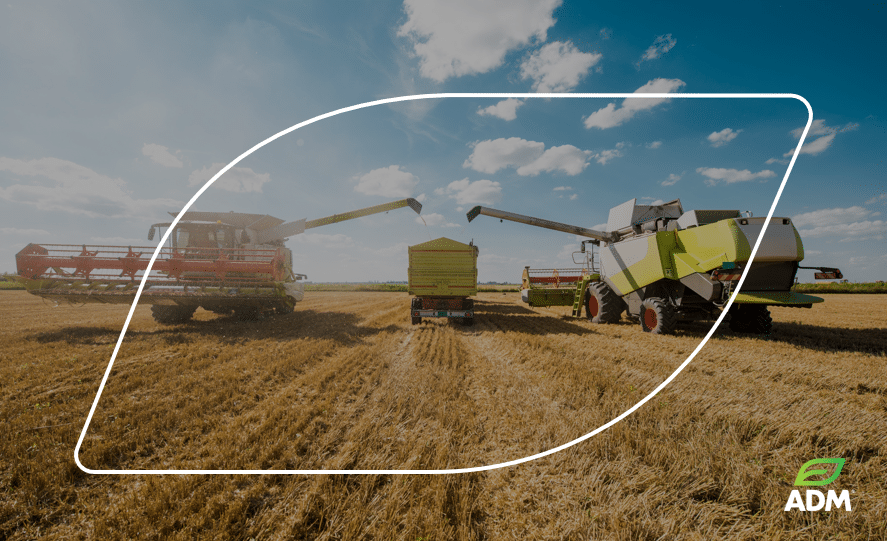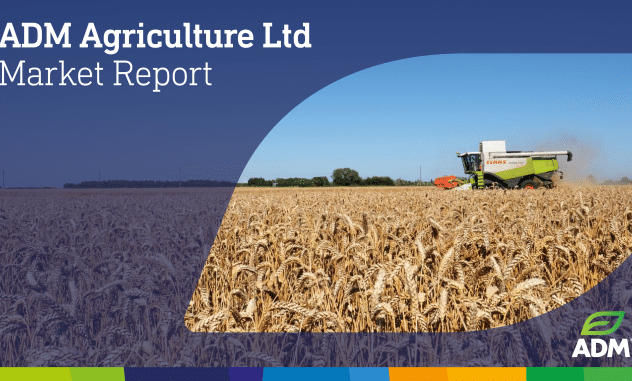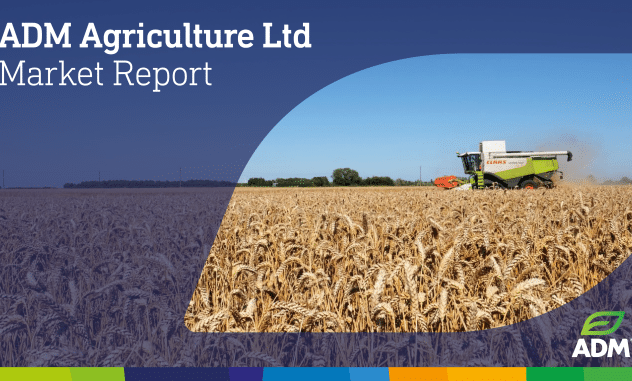WELCOME TO THE ADM AGRICULTURE WEEKLY MARKET REPORT
Wheat
- After a month of slow fundamental news, wheat markets had a lot to digest this week with this month’s USDA report showing a much tighter supply for the global wheat crop. Chicago snapped its near three-month downtrend staging something of a reversal having hit its lowest level in three years.
- This minor rally is primarily being driven by a more supportive September USDA report, key takeaways were the downward revision in global wheat production from 793.37 to 787.34mmt for 2023/24, compared to 790.59mmt for 2022/23 as well as a reduction in global ending stocks by 7mmt well below trade estimates.
- The report also highlighted some regional changes with Australian wheat production down to 26mmt in line with the ABARES estimates. Surprisingly the report left Russian wheat production unchanged despite trade expectations of an increase.
- The above with a combination of more drone attacks targeting the Danube ports this week, the market is starting to incorporate some sort of risk premium as fears of wider escalation in Ukraine continue with the promise of further military aid being provided by Western powers.
- Managed money still maintains its large short positions across wheat and the grains complex, but with the rally we have seen this caused a spurt of short covering further fuelling the short-lived rally we have seen.
- EU markets continue to be a follower with Matif trading higher on the week for the most active contract. Prices remain subdued and although it has been dragged up by the rally in Chicago, the slow pace of exports from the continent continues to weigh on prices. The USDA report did paint a picture of a tighter S&D, export demand remains challenging with the ongoing battle with Black Sea grain for export competitiveness.
- UK markets remained steady throughout the week, although trading higher at the back end of the week corresponding with the rise in global prices. However, a week typified by slow farmer selling with a focus more on the premium grades at the expense of feed to try to maximise ex-farm revenues. On the export front, UK wheat remains uncompetitive losing ground this week, being out-competed by other origins into Ireland as well as looking expensive in the domestic ration versus feed barley.
Malting Barley
- The malting barley market continues to slide as domestic demand remains elusive, meanwhile farmers continue to readily sell malting quality at historically excellent premiums of over £75/mt.
- FOB markets are similarly slow, and we would not be surprised to see further pressure to quality premiums; particularly in the OND’23 position as most buyers are focussing on procuring JFM’24/AMJ’24, and farmers continue to look favour movement in the pre-Christmas window.
Feed Barley
- For another week the feed barley market is struggling with a lack of supply. Farmers in the UK are not showing interest in selling any meaningful volume of feed-grade products at current levels, and instead are focussing their time on land work/drilling for next year’s crop. Domestic basis continues to squeeze higher in an effort to ration demand amid this slow supply.
- It is important to note that we are once again uncompetitive for pricing any significant quantity of exports, finding competition from other barley origins and from competitive feed wheat offers ex Germany/Poland. If we do see the UK farmer come back to the table, then we could see prices push sharply lower in order to price into the export flow.
Rapeseed
- The main news this week has been the USDA report we saw on Tuesday giving a neutral to bearish outcome vs. the bullish expectation. Both Russia and Ukraine unfortunately continue to launch drone and missile strikes on enemy port infrastructure and grain facilities, adding additional war premium. Russia have continued their attacks along the Danube River and Ukraine struck a Russian landing vessel and submarine in Crimea.
- CBOT soybeans trade close to nearby support levels despite trying to push higher at the start of the week. Crop ratings fall 1% to 52% good/excellent ahead of the report though this is seen as a seasonal adjustment for this time of year. As expected, the USDA reduced the average yield to the expected level of 50.1 bpa vs. 50.9 bpa last month. Ending stocks came in at 220 mbu, lower than 245 mbu in Aug but higher than the expected tonnage of 209 mbu. World ending stocks came in at 119.25 mmt vs. 119.4mmt last month but the trade did expect a fall to 118.5 mmt.
- Weather in U.S has been dry this week with seasonal temperatures, although they are set to rise in the coming days across the Midwest, with showers in the longer-term forecast.
- The USDA announced one sale of 121,000t beans this week to an unknown and one sale of meal to the Philippines.
- Energy markets have had another strong week, with crude reaching new highs at levels we haven’t seen in 10 months. Saudi Aramco has notified five North Asian buyers that it will supply full contractual volumes of crude in October, prolonging the 1 million barrel per day cut to the end of the year. This week’s EIA report showed surprisingly higher stocks of crude and gasoline, capping gains on Wednesday.
- Veg oils have struggled this week as Malaysian reserves rise 23% to 2.12 million tons in August, the highest jump in two years. Exports fell 9.8% to 1.22 million tons and local consumption dropped 27% to 251,000t. Soy oil saw some positivity as diesel prices rallied and saw support from the slight increase in Soybean oil usage in biofuels, but it still fell slightly behind expectations.
- Canola markets are down this week as yields improve through harvest progression. StatsCan reports canola stocks at 1.506mmt as of July 31, nearly double last year but still below expectations. If improved yields continue, we could see a crop higher than 17.5mmt compared to the current expected 16mmt.
- MATIF rapeseed has now broken €440 support and is heading towards next support at €400 following USDA support giving weakness to soybeans. The Nov/Feb spread now sits at the lowest level in 5 years with Nov looking short-term oversold. We still see no farmer selling in the UK at these levels.
- Sterling trades at 1.16300.
Oats
- Oat markets saw another week of talk of a tightening global balance sheet, which resulted in buyers needing to increase their bid prices to draw out offers.
- Sellers in Scandinavia remain few and far between and with reports of poor quality we could see exporters withdraw from markets further.
- German millers are starting to come into the market to hedge against retail demand and this could push prices up in the short term.
- Strong demand for both feed and milling grade oats remains in Spain with some trades being reported in the last week for Sept/Oct positions.
- Here in the UK, good weather last week meant many growers could harvest a large amount of their remaining spring crops.
- Quality of these late harvested spring crops are poor with many samples testing below 44kg/hl.
- Analysis of samples through our TASCC assured lab sees averages of 50.56kg/hl and 49.16kg/hl for winters and springs respectively, with screenings and admix testing low.
- Bottom line, oat prices remain high relative to other grains due to strong demand and lower global supplies.
Pulses
Peas
- The pea harvest is now complete. Growers who left it late to cut their peas surprisingly found relative success in quality and had average yields for the season – initially, the view was those late crops would be very poor.
- Samples are still coming in to be tested each week for peas providing a clearer picture on the overall quality of the crop. Marrowfat peas still look excellent quality wise, with bleaching figures averaging at just below 7%, moistures around the five-year average of 14.5%, and insect damage low in comparison to last year, with an average of 0.9% vs. 2% in the 2022/23 season. Green pea samples were slower to reach the lab. Over the last week however, we saw a large spike in testing and sampling, providing us an average figure of 8.5% bleached with 67% of current growers meeting packing grade specifications.
- Yellow peas performed particularly well at harvest both on yield and quality performance this season, strong resistance against disease and standing ability in our varieties appears to have aided this impressive year.
- Open market values for green peas are still firm on the week as the global planting rate was down year on year. The need for high quality and sub 5% bleached across Europe is driving demand and thus increasing the premium between packing (below 10% bleached) and decort (over 10% bleached) greens.
- We are in the market for either type of green peas and will provide a competitive bid. Please get in touch with your farm trader for more information.
- Long Sutton will continue to produce marrowfats up until the end of this week before moving on to Green Peas for 2 working weeks to provide cover for our customers as well as meeting contract requirements of our growers.
- We are planning the next VIPea event for Q4 of 2023 and will circulate more information to our grower’s group in the coming weeks. We would like to discuss this season’s harvest performance and ways to improve for the 2024 campaign. If you are not part of our grower’s group, please contact your farm trader to become a VIPea!
Beans
- Feed bean prices saw very little movement week on week and are around similar levels to this time last week. Growers have started popping up more in terms of sales to try to get their beans off the farm as quickly as possible.
- Yields in the Baltics are coming out better than expected. Quality is worse, however, meaning more feed will be available than in a typical season. Baltics traditionally are strong sellers for Q3 & Q4. Currently, they are undercutting UK values taking up a lot of the general export demand at 10 Euros cheaper than our current bids. Most of their exportable surplus will be shipped during or before January, which could lead to demand for UK feed in Q1 of 2024.
- Human consumption wise, both the UK and the Baltic’s crops are very poor quality and there is not a huge amount of volume available, meaning that premiums are likely to be firm to seek out the higher quality. Insect damage is much higher year on year in the UK, which results in the lack of HC-grade beans.
Seed
- As the autumn drilling campaign is now well underway, we are beginning to see pressure on availability across the board.
- Winter barley seed is now very limited across the trade. However, we do still have availability of LG Caravelle, the highest-yielding 2-row feed barley on the AHDB RL.
- As to be expected on the winter wheat, KWS Dawsum, Champion and KWS Extase (among others) are all proving to be extremely popular this year.
- The AHDB harvest results are showing great promise for Group 3 soft wheat Bamford and Group 4 feed wheat LG Beowulf, both of which will have seed commercially available for drilling autumn 2024.
- It is not too late to order your cover crop mix! Cover crops are a great option for winter grazing and provide a range of benefits to the soil, including decreasing soil compaction and increasing organic matter. Check out our video on catch/ cover cropping within an arable rotation for more information.
- Looking to resow your grass this autumn? We have a range of grass mixes available, whether you are after a short or long-term ley, there is a mix to suit your requirements.
Fertiliser
- Prilled and granular urea pricing appears to have reached a short-term price floor but looks set to remain firm heading into Q4. Values are supported by an earlier-than-expected follow-up Indian import tender, set to close on 15 September, along with uncertainty over future Chinese export volumes.
- We have granular urea available for delivery September through to March next year, with or without inhibitor technology.
- UK AN offers remain withdrawn at present, and any imported offers are limited with many continuing to avoid the UK market.
- Obtaining new prices for AN product from European producers is continuing to prove difficult for UK importers.
- Given the change in the North African nitrogen markets, firm energy costs, and spiraling ammonia prices, most suppliers appear reluctant to make any commitments.
- We have granular NS products to offer in the October/November delivery window. Borealis 27N + 10SO3 and SKW Piamon 33N + 30SO3 are both granular compound products and continue to be favoured by buyers.
- The phosphate market’s current focus is on whether suppliers can achieve further DAP price increases in India following last week’s rebound. East of Suez the feeling seems to be bullish as Indian buyers have jumped to replenish stocks and Chinese DAP/MAP exports continue to be restricted.
| £/€ | £/$ | €/$ |
|---|---|---|
| 1.16 | 1.25 | 1.07 |
| Feed Barley £ | Wheat £ | Beans £ | Oilseed Rape £ | |
|---|---|---|---|---|
| Sep 2023 | 155-165 | 184-188 | 213-218 | 340-345 |
NB: Prices quoted are indicative only at the time of going to press and subject to location and quality.
“Although ADM Agriculture take steps to ensure the validity of all information contained within the ADM Agriculture Market Report, it makes no warranty as to the accuracy or completeness of such information. ADM Agriculture will have no liability or responsibility for the information or any action or failure to act based upon such information.”
ADM Agriculture cannot accept liability arising from errors or omissions in this publication.
ADM Agriculture trade under AIC contracts which incorporate the arbitration clause.
Terms and Conditions of Purchase.
On every occasion, without exception, grain and pulses will be bought by incorporating by reference the terms & conditions of the AIC No.1 Grain and Peas or Beans contract applicable on the date of the transaction. Also, we will always, and without exception, buy oilseed rape and linseed by incorporating by reference the terms & conditions of the respective terms of the FOSFA 26A and the FOSFA 9A contracts applicable on the date of the transaction. It is a condition of all such transactions that the seller is deemed to know, accept and understand the terms and conditions of each of the above contracts.



